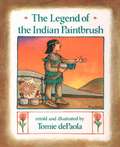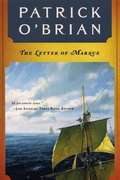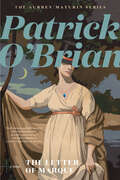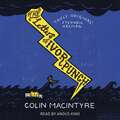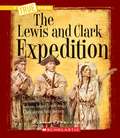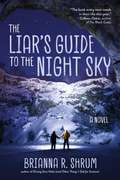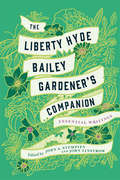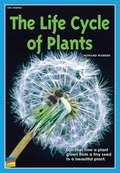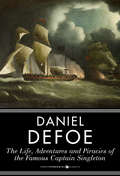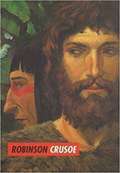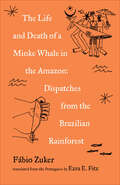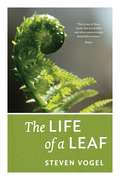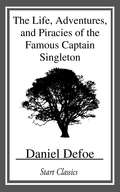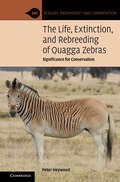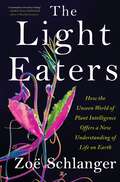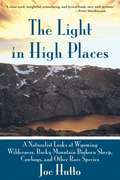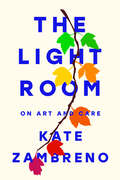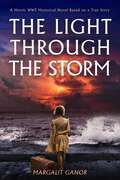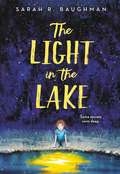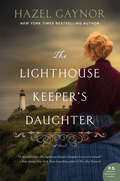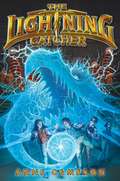- Table View
- List View
The Legend of the Indian Paintbrush
by Tomie dePaolaIn spring, the hills and meadows of Texas and Wyoming are ablaze with the reds, oranges, and yellows of the Indian Paintbrush. How this striking plant received its name is told in an old Indian legend.Many years ago, when the People traveled the Plains, a young Indian boy had a Dream-Vision in which it was revealed that one day he would create a painting that was as pure as the colors of the evening sky at sunset. The boy grew up to become the painter of the tribe, but although he found a pure white buckskin for a canvas and made paints from the brightest flowers and the reddest berries, he could not capture the sunset.How the young Indian artist finally fulfills his Dream-Vision is lovingly told and illustrated by Tomie dePaola, in words and pictures that capture the spirit and beauty of this dramatic legend.
The Less Is More Garden: Big Ideas for Designing Your Small Yard
by Susan Morrison“Gives homeowners solid ideas to help transform small gardens into a personalized, thoughtful, and unique destinations.” —Gardenista When it comes to gardens, bigger isn’t always better. A smaller space requires fewer plants and less time to design, install, and maintain. The Less Is More Garden shows you how to take advantage of every square foot of space. Designer Susan Morrison offers savvy tips to match your landscape to your lifestyle, draws on years of experience to recommend smart plants with seasonal interest, and suggests hardscape materials to personalize your space. Inspiring photographs highlight a variety of inspiring small-space designs from around the country. With The Less Is More Garden, you’ll see how limited space can mean unlimited opportunities for gorgeous garden design.
The Letter of Marque
by Patrick O'BrianCaptain Jack Aubrey, a brilliant and experienced officer, has been struck off the list of post-captains for a crime he did not commit. His old friend Stephen Maturin, usually cast as a ship's surgeon to mask his discreet activities on behalf of British Intelligence, has bought for Aubrey his former ship the Surprise to command as a privateer, more politely termed a letter of marque. Together they sail on a desperate mission against the French, which, if successful, may redeem Aubrey from the private hell of his disgrace.
The Letter of Marque (Aubrey/Maturin Novels #12)
by Patrick O'Brian"Fine stuff...[The Letter of Marque] leaves the devotee of naval fiction eager for sequels."--Jonathan Yardley, Washington Post Book World Captain Jack Aubrey, a brilliant and experienced officer, has been struck off the list of post-captains for a crime he did not commit. His old friend Stephen Maturin, usually cast as a ship's surgeon to mask his discreet activities on behalf of British Intelligence, has bought for Aubrey his former ship the Surprise to command as a privateer, more politely termed a letter of marque. Together they sail on a desperate mission against the French, which, if successful, may redeem Aubrey from the private hell of his disgrace.
The Letters of Ivor Punch: Winner Of The Edinburgh Book Festival First Book Award
by Colin MacIntyreImagine an island, a place separated from the mainland by choppy seas. A place of myths and faith, where a Headless Horseman is said to stalk the woods but where the kirk is always full.Imagine a community which held its own against Darwin but which can't hold on to its own.Prepare to meet a pioneering female travel writer, two fatherless boys, and a man who, quite simply, fell from the sky. And, at the centre of it all, the figure who links the past to the present - the irrepressible, unforgettable former Sergeant Punch.Ivor Punch will not be taking his secrets to the grave. He's going to share them: with a departed relative, with President Obama and, especially, with you.Hilarious and heartfelt, rowdy and true, THE LETTERS OF IVOR PUNCH is a novel about fathers and sons, secrets and lies and how, sometimes, you have to leave home to know what home is.Read by Angus King(p) 2015 Orion Publishing Group
The Lewis And Clark Expedition (True Books: Westward Expansion)
by John PerritanoComprehensive text about the Lewis and Clark expedition in the Louisiana territory in preparation for the Louisiana Purchase.
The Liar's Guide to the Night Sky: A Novel
by Brianna R. ShrumPerfect for fans of the New York Times bestselling novel, Love & Gelato by Jenna Evans Welch It's no one&’s fault that Hallie Jacob is alone. That her grandpa got sick half a world away and so her parents yanked her to Colorado the last semester of her senior year. That career-wise, she&’s specialized in fighting fire, and now she&’s surrounded by ice, snow, and a thousand cousins she&’s half-banned from hanging around with. But that&’s what's happened. That's what her December looks like. On one big family weekend in the freaking tundra, Hallie sneaks off with those cousins to an abandoned ski slope. But they get caught in a random mudslide, and what started as a Secret Bonfire Party goes in a Potential Donner Party direction real fast. With some cousins in desperate need of medical attention, Hallie leaves their camp for help—and is surprised when Jonah Ramirez (her cousin's extremely off-limits—absurdly hot—best friend) joins her. Facing paralyzing temperatures, sharp-toothed animals strong enough to survive a climate with hardly any water or air, and weather phenomena so wicked they&’ll wreck a mountain before you can blink, Jonah and Hallie have no choice but to trust each other as they search for the way to town to send help back to their stranded friends and family. And THAT may be more impossible, even, than making it out alive.
The Liberty Hyde Bailey Gardener's Companion: Essential Writings
by Liberty Hyde Bailey"Every family can have a garden." -Liberty Hyde BaileyFinally, the best and most accessible garden writings of perhaps the most influential literary gardener of the twentieth century have been brought together in one book. Philosopher, poet, naturist, educator, agrarian, scientist, and garden-lover par excellence Liberty Hyde Bailey built a reputation as the Father of Modern Horticulture and evangelist for what he called the "garden-sentiment"—the desire to raise plants from the good earth for the sheer joy of it and for the love of the plants themselves. Bailey's perennial call to all of us to get outside and get our hands dirty, old or young, green thumb or no, is just as fresh and stirring today as then.Full of timeless wit and grace, The Liberty Hyde Bailey Gardener's Companion collects essays and poems from Bailey's many books on gardening, as well as from newspapers and magazines from the era. Whether you've been gardening for decades or are searching for your first inspiration, Bailey's words will make an ideal companion on your journey.
The Lichen Museum (Art After Nature)
by Laurie A. PalmerA radical proposal for how a tiny organism can transform our understanding of human relations Serving as both a guide and companion publication to the conceptual art project of the same name, The Lichen Museum explores how the physiological characteristics of lichens provide a valuable template for reimagining human relations in an age of ecological and social precarity. Channeling between the personal, the scientific, the philosophical, and the poetic, A. Laurie Palmer employs a cross-disciplinary framework that artfully mirrors the collective relations of lichens, imploring us to envision alternative ways of living based on interdependence rather than individualism and competition.Lichens are composite organisms made up of a fungus and an alga or cyanobacteria thriving in a mutually beneficial relationship. The Lichen Museum looks to these complex organisms, remarkable for their symbiosis, diversity, longevity, and adaptability, as models for relations rooted in collaboration and nonhierarchical structures. In their resistance to fast-paced growth and commodification, lichens also offer possibilities for humans to reconfigure their relationship to time and attention outside of the accelerated pace of capitalist accumulation.Drawing together a diverse set of voices, including personal encounters with lichenologists and lichens themselves, Palmer both imagines and embodies a radical new approach to human interconnection. Using this tiny organism as an emblem through which to navigate environmental and social concerns, this work narrows the gap between the human and natural worlds, emphasizing the notion of mutual dependence as a necessary means of survival and prosperity.
The Life Cycle of Plants
by Howard WarrenPerform this script about a girl's quest to save the buffalo from extinction.
The Life Cycles of Butterflies: From Egg to Maturity, a Visual Guide to 23 Common Garden Butterflies
by Judy Burris Wayne RichardsThis stunning photographic guide will have butterfly enthusiasts of all ages aflutter. Judy Burris and Wayne Richards include more than 400 full-color, up-close images that present the life cycles of 23 common North American butterflies in amazing detail. Watch caterpillars hatch from eggs, eat and grow, form into chrysalides, emerge as colorful butterflies, and fly through the air. You’ll also learn which plants butterflies avoid and which native species they’re attracted to, so you can create your own backyard butterfly haven.
The Life and Adventures and Piracies of the Famous Captain Singleton
by Daniel DefoeAfter being kidnapped from his family as a child, Bob Singleton is raised by the gypsy who purchased him. As a young man, he quickly takes to life at sea, and begins a series of adventures, both on and off land, eventually becoming a successful pirate known as Captain Singleton. The Life, Adventures and Piracies of the Famous Captain Singleton is written much in the same style as author Daniel Defoe’s other famous novels, including Robinson Crusoe and Journal of the Plague Year, mixing accounts of adventure with well-researched economic and practical details that ground the story in the reality of its 18th century setting. <P><P>HarperPerennial Classics brings great works of literature to life in digital format, upholding the highest standards in ebook production and celebrating reading in all its forms. Look for more titles in the HarperPerennial Classics collection to build your digital library.
The Life and Adventures of Robinson Crusoe (Core Classics)
by Michael J. Marshall Daniel DafoeCore Classics Series Stories loved for generations come to life for today's young readers in the Core Classics series. Faithful to the style, plot, and themes of the originals, Core Classics are designed for use as classroom editions of the literary works listed in the Core Knowledge Sequence. They include introductions by E. D. Hirsch Jr., editor of the Core Knowledge Series (What Your Kindergartner — Sixth Grader Needs to Know). The Core Classics are generally considered suitable for fourth and fifth grade students. The texts are illustrated, annotated, and include a brief biography of the author.<P><P> From the Introduction<P><P> The story of Robinson Crusoe was inspired by a real-life castaway. In 1705, Alexander Selkirk, a Scotsman, argued angrily with the captain of his ship over whether their boat was too leaky to sail. After the boat stopped to get fresh water at an island in the Pacific Ocean, Selkirk refused to go back on board. So the captain left him there alone with a Bible, a gun, a kettle, and a few tools and supplies. Four-and-a-half years later another English ship visiting the island saw a signal fire and found Selkirk still alive. Today, the island is named for him.
The Life and Death of a Minke Whale in the Amazon: Dispatches from the Brazilian Rainforest
by Fábio ZukerAs the Amazon burns, Fábio Zuker shares stories of resistance, self-determination, and kinship with the land. In 2007, a seven-ton minke whale was found stranded on the banks of the Tapajós River, hundreds of miles into the Amazon rainforest. For days, environmentalists, journalists, and locals followed the lost whale, hoping to guide her back to the ocean, but ultimately proved unable to save her. Ten years later, journalist Fábio Zuker travels to the state of Pará, to the town known as “the place where the whale appeared,” which developers are now eyeing for mining, timber, and soybean cultivation. In these essays, Zuker shares intimate stories of life in the rainforest and its surrounding cities during an age of raging wildfires, mass migration, populist politics, and increasing deforestation. As a group of Venezuelan migrants wait at a bus station in Manaus, looking for a place more stable than home, an elder in Alter do Chão becomes the first Indigenous person in Brazil to die from COVID-19 after years of fighting for the rights and recognition of the Borari people. The subjects Zuker interviews are often torn between ties with their ancestral territories and the push for capitalist gain; The Life and Death of a Minke Whale in the Amazon captures the friction between their worlds and the resilience of movements for autonomy, self-definition, and respect for the land that nourishes us.
The Life of a Leaf
by Steven VogelIn its essence, science is a way of looking at and thinking about the world. In The Life of a Leaf, Steven Vogel illuminates this approach, using the humble leaf as a model. Whether plant or person, every organism must contend with its immediate physical environment, a world that both limits what organisms can do and offers innumerable opportunities for evolving fascinating ways of challenging those limits. Here, Vogel explains these interactions, examining through the example of the leaf the extraordinary designs that enable life to adapt to its physical world. In Vogel's account, the leaf serves as a biological everyman, an ordinary and ubiquitous living thing that nonetheless speaks volumes about our environment as well as its own. Thus in exploring the leaf's world, Vogel simultaneously explores our own. A companion website with demonstrations and teaching tools can be found here: http://www.press.uchicago.edu/sites/vogel/index.html
The Life, Adventures, and Piracies of
by Daniel DefoeThe narrative describes the life of an Englishman, stolen from a well-to-do family as a child and raised by Gypsies who eventually makes his way to sea.One half of the book concerns Singleton's crossing of Africa and the later half concerns his life as a pirate in the Indian Ocean and Arabian Sea. Defoe's description of piracy focuses for the most part on matters of economics and logistics, making it an intriguing if not particularly gripping read. Singleton's pirate behaves more like a merchant adventurer, perhaps Defoe's comment on the mercantilism of his day.
The Life, Extinction, and Rebreeding of Quagga Zebras: Significance for Conservation (Ecology, Biodiversity and Conservation)
by Peter HeywoodQuaggas were beautiful pony-sized zebras in southern Africa that had fewer stripes on their bodies and legs, and a browner body coloration than other zebras. Indigenous people hunted quaggas, portrayed them in rock art, and told stories about them. Settlers used quaggas to pull wagons and to protect livestock against predators. Taken to Europe, they were admired, exhibited, harnessed to carriages, illustrated by famous artists and written about by scientists. Excessive hunting led to quaggas' extinction in the 1880s but DNA from museum specimens showed rebreeding was feasible and now zebras resembling quaggas live in their former habitats. This rebreeding is compared with other de-extinction and rewilding ventures and its appropriateness discussed against the backdrop of conservation challenges—including those facing other zebras. In an Anthropocene of species extinction, climate change and habitat loss which organisms and habitats should be saved, and should attempts be made to restore extinct species?
The Light Eaters: How the Unseen World of Plant Intelligence Offers a New Understanding of Life on Earth
by Zoë SchlangerNEW YORK TIMES BESTSELLER The New Yorker’s Best Books of 2024 • TIME’s 10 Best Nonfiction Books of 2024 • New York Magazine’s 10 Best Books of the Year • Washington Post’s 50 Notable Works of Nonfiction of 2024 • Smithsonian’s 10 Best Science Books of the Year • A Best Book of the Year: Boston Globe, Scientific American, New York Public Library, Christian Science Monitor, Library Journal, and Publishers Weekly • An Amazon Best Nonfiction Book of the YearLonglisted for the National Book Critics Circle Nonfiction Prize • Finalist for the Los Angeles Times Book Prize • Winner of the National Outdoor Book Award for Natural History“A masterpiece of science writing.” –Robin Wall Kimmerer, author of Braiding Sweetgrass“Mesmerizing, world-expanding, and achingly beautiful.” –Ed Yong, author of An Immense World“Rich, vital, and full of surprises. Read it!” –Elizabeth Kolbert, author of Under a White Sky and The Sixth Extinction Award-winning Atlantic staff writer Zoë Schlanger delivers a groundbreaking work of popular science that probes the hidden world of the plant kingdom, “destabilizing not just how we see the green things of the world but also our place in the hierarchy of beings, and maybe the notion of that hierarchy itself.” (The New Yorker)It takes tremendous biological creativity to be a plant. To survive and thrive while rooted in a single spot, plants have adapted ingenious methods of survival. In recent years, scientists have learned about their ability to communicate, recognize their kin and behave socially, hear sounds, morph their bodies to blend into their surroundings, store useful memories that inform their life cycle, and trick animals into behaving to their benefit, to name just a few remarkable talents.The Light Eaters is a deep immersion into the drama of green life and the complexity of this wild and awe-inspiring world that challenges our very understanding of agency, consciousness, and intelligence. In looking closely, we see that plants, rather than imitate human intelligence, have perhaps formed a parallel system. What is intelligent life if not a vine that grows leaves to blend into the shrub on which it climbs, a flower that shapes its bloom to fit exactly the beak of its pollinator, a pea seedling that can hear water flowing and make its way toward it? Zoë Schlanger takes us across the globe, digging into her own memories and into the soil with the scientists who have spent their waking days studying these amazing entities up close.What can we learn about life on Earth from the living things that thrive, adapt, consume, and accommodate simultaneously? More important, what do we owe these life forms once we come to understand their rich and varied abilities? Examining the latest epiphanies in botanical research, Schlanger spotlights the intellectual struggles among the researchers conceiving a wholly new view of their subject, offering a glimpse of a field in turmoil as plant scientists debate the tenets of ongoing discoveries and how they influence our understanding of what a plant is.We need plants to survive. But what do they need us for—if at all? An eye-opening and informative look at the ecosystem we live in, this book challenges us to rethink the role of plants—and our own place—in the natural world.
The Light In High Places: A Naturalist Looks at Wyoming Wilderness--Rocky Mountain Bighorn Sheep, Cowboys, and Other Rare Species
by Joe HuttoNaturalist Joe Hutto's latest adventures in wildlife observation take him to Wyoming's Wind River Mountains. Hutto is living in a tent at 12,000 feet, where blizzards occur in July and where human wants become irrelevant and human needs can become a matter of life and death-to study the Rocky Mountain bighorn sheep. The population of these rare alpine sheep is in decline. The lambs are dying in unprecedented numbers. Hutto's job is to find out why. For months at a time, he follows the bighorn herds, meets mountain lions and bears, weathers injury and storms, and beautifully observes the incredible splendor of the Rocky Mountains. Hutto has a deep connection to Wyoming, having managed a large cattle ranch in his past. He weaves Wyoming's history of the cowboy, mountain ecology, and the lives of the bighorn sheep into a beautiful flowing narrative. Ultimately, he discovers that the lambs are dying of a form of nutritional muscular dystrophy due to selenium deficiency, which is caused by acid rain-a grim ecological disaster caused by human pollution. Here is a new twist on a cautionary tale, and a new voice, eloquently ex-pressing the urgency that we mend our ways.
The Light Room
by Kate Zambreno&“Kate Zambreno has invented a new form. It is a kind of absolute present, real life captured in closeup.&“ —Annie Ernaux, winner of the Nobel Prize in Literature From &“one of our most formally ambitious writers&” (Esquire), a moving account of caretaking in a time of uncertainty and lossIn The Light Room, Zambreno offers her most profound and affecting work yet: a candid chronicle of life as a mother of two young daughters in a moment of profound uncertainty about public health, climate change, and the future we can expect for our children. Moving through the seasons, returning often to parks and green spaces, Zambreno captures the isolation and exhaustion of being home with a baby and a small child, but also small and transcendent moments of beauty and joy. Inspired by writers and artists ranging from Natalia Ginzburg to Joseph Cornell, Yūko Tsushima to Bernadette Mayer, Etel Adnan to David Wojnarowicz, The Light Room represents an impassioned appreciation of community and the commons, and an ecstatic engagement with the living world.How will our memories, and our children&’s, be affected by this time of profound disconnection? What does it mean to bring new life, and new work, into this moment of precarity and crisis? In The Light Room, Kate Zambreno offers a vision of how to live in ways that move away from disenchantment, and toward light and possibility.
The Light Through the Storm: A Heroic WW2 Historical Novel Based on a True Story
by Margalit GanorA perilous journey through the unthinkable. A riveting story of hope and survival. Can their faith shield them against unbridled hatred?August, 1942. When they realize the danger of remaining under the rule of the Nazi occupation, Dr. Leon Schmelzer, his wife Donya, and their baby daughter attempt to flee Romania under the cover of darkness. Joining a dozen other brave souls, they hastily board a small ship, leaving behind family, friends, and the only life they ever knew—for a slim chance at survival.But their path to freedom does not sail over smooth waters. As endless waves threaten to drown what little hope they have, the desperate refugees find that the hatred in the hearts of men is more terrifying than any force of nature. And when they are shipwrecked and taken captive in a foreign land, Leon&’s own faith and resolve are put to the ultimate test. Can he find the courage and resourcefulness to protect his wife and only daughter?
The Light in High Places
by Joe HuttoHutto is living in a tent at twelve thousand feet, where blizzards occur in July and where human wants become irrelevant and human needs can become a matter of life and death-to study the Rocky Mountain bighorn sheep. The population of these rare alpine sheep is in decline. The lambs are dying in unprecedented numbers. Hutto's job is to find out why.For months at a time, he follows the bighorn herds, meets mountain lions and bears, weathers injury and storms, and beautifully observes the incredible splendor of the Rocky Mountains.Hutto has a deep connection to Wyoming, having managed a large cattle ranch in his past. He weaves Wyoming's history of the cowboy, mountain ecology, and the lives of the bighorn sheep into a beautiful flowing narrative. Ultimately, he discovers that the lambs are dying of cystic fibrosis due to selenium deficiency, which is caused by acid rain-a grim ecological disaster caused by human pollution. Here is a new twist on a cautionary tale, and a new voice, eloquently expressing the urgency that we mend our ways.
The Light in the Lake
by Sarah BaughmanA remarkable debut novel that takes readers on a journey of discovery, magic, science, and hope. <P><P>Twelve-year-old Addie should stay away from Maple Lake. After all, her twin brother, Amos, drowned there only a few months ago. But its crisp, clear water runs in Addie's veins, and the notebook Amos left behind -- filled with clues about a mysterious creature that lives in the lake's inky-blue depths -- keeps calling her back. <P><P>So despite her parents' fears, Addie accepts a Young Scientist position studying the lake for the summer, promising she'll stick to her job of measuring water pollution levels under adult supervision. <P><P>Still, Addie can't resist the secrets of Maple Lake. She enlists the lead researcher's son, Tai, to help her investigate Amos's clues. As they collect evidence, they also learn that Maple Lake is in trouble -- and the source of the pollution might be close to home. <P><P>Addie finds herself caught between the science she has always prized and the magic that brings her closer to her brother, and the choice she makes will change everything.
The Lighthouse Keeper's Daughter: A Novel
by Hazel GaynorFrom The New York Times bestselling author of The Girl Who Came Home comes a historical novel inspired by true events, and the extraordinary female lighthouse keepers of the past two hundred years.“They call me a heroine, but I am not deserving of such accolades. I am just an ordinary young woman who did her duty.”1838: Northumberland, England. Longstone Lighthouse on the Farne Islands has been Grace Darling’s home for all of her twenty-two years. When she and her father rescue shipwreck survivors in a furious storm, Grace becomes celebrated throughout England, the subject of poems, ballads, and plays. But far more precious than her unsought fame is the friendship that develops between Grace and a visiting artist. Just as George Emmerson captures Grace with his brushes, she in turn captures his heart.1938: Newport, Rhode Island. Nineteen-years-old and pregnant, Matilda Emmerson has been sent away from Ireland in disgrace. She is to stay with Harriet, a reclusive relative and assistant lighthouse keeper, until her baby is born. A discarded, half-finished portrait opens a window into Matilda’s family history. As a deadly hurricane approaches, two women, living a century apart, will be linked forever by their instinctive acts of courage and love.
The Lightning Catcher
by Anne CameronWelcome to the Perilous Exploratorium for Violent Weather and Vicious Storms. Be prepared for: 1. Extreme weather2. Extreme action3. Extreme laughter4. Extreme friendship5. extreme dangerProceed at your own risk.
